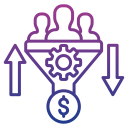Chosen theme: Data-Driven Decision Making in Funnel Optimization. Welcome! Here we turn scattered clicks into confident, evidence-backed decisions that move metrics and morale. If you want fewer debates and more results, you’re in the right place—subscribe, ask questions, and share your funnel challenges so we can explore them together.
What Data-Driven Really Means for Your Funnel
From Gut Feel to Evidence
A B2B SaaS team once swore the pricing page was their biggest leak. Event data showed activation collapsed during permissions setup, not pricing. By rewriting guidance and adding a single progress hint, activation rose notably within two weeks. Share your biggest hunch-versus-data surprise.
Actionable Metrics, Not Vanity
Pageviews feel good but rarely direct decisions. Actionable metrics connect a specific change to a predicted impact on a funnel stage. Define targets like activation rate, time-to-value, or qualified signup rate. Comment with one metric you’ll retire and one you’ll adopt this quarter.
Decisions as the Unit of Progress
Store each decision with its hypothesis, metric, and expected lift. Revisit after enough data accumulates to judge the outcome. This habit turns data into durable organizational learning. Start a simple decision log today and invite teammates to add hypotheses they are ready to test.
Instrumentation and Data Quality Across Every Stage
A Practical Tracking Plan
Define a clear event taxonomy with names, properties, and ownership. Include signup, activation milestones, intent signals, and conversion outcomes. Version your plan, document schema changes, and test events in staging. Post your must-track events and we will share a peer-reviewed checklist.
One Source of Truth
Choose a canonical warehouse or metrics layer so teams stop debating numbers. Reconcile discrepancies with observability alerts and anomaly detection. Standardize definitions for signup, activation, and conversion. Comment if multiple dashboards tell different stories—we’ll suggest steps to unify them.
Privacy That Builds Trust
Design data collection with consent, minimization, and purpose limitations. Hash identifiers where possible and restrict sensitive fields. Good privacy practices reduce risk and increase customer trust, improving later-stage conversions. Ask about building privacy into your funnel without losing analytical depth.
Finding Leaks with Analytical Frameworks
A single funnel snapshot can hide time-based effects. Cohorting by acquisition week or channel reveals whether improvements persist. One startup found weekend signups looked healthy but never activated. Segment your data and post your most surprising cohort pattern for feedback.
Solid Hypotheses and Pre-Reads
Write test briefs with a causal rationale, target segment, expected effect size, and success criteria. Pre-read with stakeholders to block scope creep. This prevents post-hoc fishing and focuses analysis. Post your next hypothesis draft for a quick peer review.
Power, Sample Size, and Stopping
Underpowered tests waste time and confidence. Calculate sample size, precommit to duration, and use sequential methods only if you understand error control. Document your plan. Ask us to estimate a sample size for your current baseline and target uplift.
Beyond A/B: Quasi-Experiments
When randomization is hard, use difference-in-differences, regression discontinuity, or synthetic controls. These designs demand careful assumptions and robustness checks, but unlock learning in production. Share a change you cannot A/B, and we’ll suggest a practical quasi-experimental approach.
Predictive Guidance for Smarter Moves
Score visitors on likelihood to complete key steps like signup or activation. Trigger nudges, content, or support for high-impact segments. Monitor uplift, not just accuracy. Share which micro-conversion matters most, and we’ll outline features to test in your model.


Predictive Guidance for Smarter Moves
Survival analysis estimates time until activation or churn, revealing when interventions matter most. One marketplace learned day-three prompts beat day-one nags for hesitant buyers. Post your average time-to-activate and we’ll suggest a retention-friendly cadence.



Operational Habits of a Data-Driven Team
Run weekly funnel reviews, monthly experiment retros, and quarterly bet recalibration. Keep agendas short and outcomes explicit. Rotate facilitators to spread ownership. Share your team’s current meeting cadence for suggestions that reduce noise and improve decisions.
Operational Habits of a Data-Driven Team
Pair product, marketing, data, and engineering on shared metrics, not handoffs. Create joint objectives by funnel stage to avoid local optimizations. Post one cross-team friction you face, and we’ll propose a lightweight collaboration pattern to try next sprint.
Operational Habits of a Data-Driven Team
Monitor model drift, audit feature fairness, and document exclusions. Guard against perverse incentives, like optimizing short-term conversions that erode trust. Invite readers to challenge assumptions openly. Ask for our bias audit checklist to strengthen your data-driven practice.
